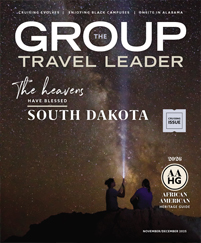‘The Great Passion Play’ and Holy Land Tour
Eureka Springs, Arkansas
Staged in an outdoor amphitheater, “The Great Passion Play” in Eureka Springs re-creates the drama of Christ’s last days on earth. A life-size set, live animals and a cast of 170 biblically costumed actors contribute to the memorable production. Performed since 1968, the play continues to be a group favorite. According to the Institute of Outdoor Theatre and Drama of East Carolina University at Greenville, it’s “America’s No. 1 Attended Outdoor Drama.”
“People can actually talk to Judas, Pontius Pilot, John and other characters before the production begins,” said director of marketing and public relations Kent Butler. “I’ve been in the play since I was 16 years old. It not only changes the lives of those sitting in the audience but also the actors’ lives as well.”
Also noteworthy, the Holy Land Tour immerses visitors in the people, culture and history of the ancient Middle East. This three-hour, interactive journey explores the culture at the time of Jesus. Groups enter through a replica of Jerusalem’s East Gate into an authentic marketplace. Visitors can mingle with re-enactors playing biblical characters from the time of Moses to Jesus Christ.
Exhibits have been researched for historical accuracy and re-created as authentically as possible. Encounters include talking with a Levitical priest in the full-scale replica of Moses’ Tabernacle in the Wilderness. Another area replicates a first-century inn typical of the inn where Mary and Joseph sought shelter. Groups can also see a first-century stable similar to the one where Jesus was born and visit the Upper Room where Jesus and his disciples feasted at the Last Supper.
Boston Avenue United Methodist Church
Tulsa, Oklahoma
Tulsa’s 8,000-member Boston Avenue United Methodist Church reigns as an architectural rock star. Its designer chose Art Deco style rather than the Gothic architecture that was popular during the 1920s.
Designated as a National Historic Landmark, the church boasts a round sanctuary and a slender 15-story tower. The limestone building incorporates abundant light and modern lines.
No expense was spared on the custom interior; it reflects Tulsa’s oil boom at that time. Pinks and purples dominate the color scheme. Broken angle arches throughout signify the blessings of God on the people and the people reaching up to God. Gorgeous stained-glass windows showcase less-traditional subjects, such as flowers. The semicircular sanctuary has five sections and houses a Möller organ with 5,869 pipes.
“The sanctuary was considered very controversial when it was constructed because it didn’t have a center aisle,” said church administrator Brenda Reed. “Our tower resembles the Empire State Building, also built in that same era.”
The Great Hall’s elongated, rectangular space has the original stained-glass skylights, wall sconces and a terrazzo floor. Mosaics that flank both ends of the hall were added in 1993 for the church’s centennial. Created in Venice, they rise three stories high. The north mosaic highlights scenes from the Old Testament, and the south mosaic depicts scenes from the New Testament.
“We have a group of volunteer docents who can give groups a wealth of information,” said Reed. “After New York City and Miami, Tulsa has more Art Deco buildings than anywhere else in the country.”









